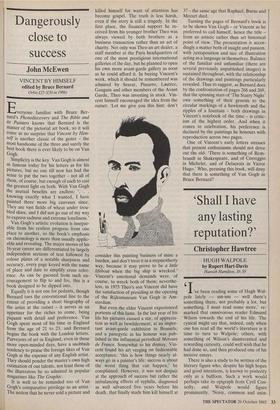Dangerously close to success
John McEwen
VINCENT BY HIMSELF edited by Bruce Bernard
Orbis £25 (£30 in 1986)
Everyone familiar with Bruce Ber- nard's Photodiscovery and The Bible and Its Painters knows that Bernard is the master of the pictorial art book, so it will come as no surprise that Vincent by Him- self is another classic of the genre – the most handsome of the three and surely the best book there is ever likely to be on Van Gogh.
Simplicity is the key. Van Gogh is almost as famous today for his letters as for his pictures, but no one till now has had the sense to put the two together – not all of them, of course, but enough of each to cast the greatest light on both. With Van Gogh the mutual benefits are endless: `. . . knowing exactly what I wanted, I have painted three more big canvases since. They are vast fields of wheat under trou- bled skies, and I did not go out of my way to express sadness and extreme loneliness.'
Van Gogh's artistic evolution is insepar- able from his restless progress from one place to another, so the book's emphasis on chronology is more than usually applic- able and revealing. The major moves of his 16-year career are differentiated by largely independent sections of text followed by colour plates of a notable sharpness and accuracy, every page keyed with the name of place and date to simplify cross refer- ence. As can be guessed from such en- couragement to flip to and fro, this is a book designed to be dipped into.
Equally it is not one for pedants, though Bernard toes the conventional line to the extent of providing a short biography of the artist at the outset – it serves as an appetiser for the riches to come, being piquant with detail and preference. Van Gogh spent most of his time in England from the age of 21 to 23, and Bernard begins the book with the London letters. Purveyors of art in England, even in these more open-minded days, have a snobbish tendency to praise the foreign likes of Van Gogh at the expense of any English artist. They should ponder the master's own high estimation of our talents, not least those of the illustrators he so admired in popular magazines like The Graphic.
It is well to be reminded too of Van Gogh's comparative privilege as an artist. The notion that he never sold a picture and
killed himself for want of attention has become gospel. The truth is less harsh, even if the story is still a tragedy. In the first place, the financial support he re- ceived from his younger brother Theo was always viewed by both brothers as a business transaction rather than an act of charity. Not only was Theo an art dealer, a staff member at the Paris headquarters of one of the most prestigious international galleries of the day, but he planned to open his own more avant-garde gallery as soon as he could afford it. In buying Vincent's work, which it should be remembered was admired by Seurat, Pissarro, Lautrec, Gauguin and other members of the Avant Garde, Theo was investing in stock. Vin- cent himself encouraged the idea from the outset: 'Let me give you this hint: don't
consider this painting business of mine a burden, and don't treat it in a stepmotherly way, because it may prove to be a little lifeboat when the big ship is wrecked.' Vincent's emotional demands were, of course, to wreck both of them; neverthe- less, in 1973 Theo's son Vincent did have the satisfaction of presiding at the opening of the Rijksmuseum Van Gogh in Am- sterdam.
But even the elder Vincent experienced portents of this fame. In the last year of his life his pictures caused a stir, of apprecia- tion as well as bewilderment, at an impor- tant avant-garde exhibition in Brussels; and a panegyric in his honour was pub- lished in the influential periodical Mercure de France. Somewhat to his dismay, Vin- cent found his art verging on fashionable acceptance: 'this is how things nearly al- ways go in a painter's life: success is about the worst thing that can happen,' he complained. However, it was not despair at the approach of success but rather the imbalancing effects of syphilis, diagnosed as well advanced five years before his death, that finally made him kill himself at
37 – the same age that Raphael, Burns and Mozart died.
Turning the pages of Bernard's book is to be shown Van Gogh – or Vincent as he preferred to call himself, hence the title from an artistic rather than art historical point of view. The presentation is accor- dingly a matter both of insight and passion, with juxtaposition and size of illustration acting as a language in themselves. Balance of the familiar and unfamiliar (there are several previously unpublished images) is sustained throughout, with the relationship of the drawings and paintings particularly revealed. Thus to suggest, as Bernard does by the confrontation of pages 268 and 269, that the spinning stars of 'The Starry Night' owe something of their genesis to the circular markings of a hawkmoth and the ripples of a fountain – both drawings in Vincent's notebook of the time – is critic- ism of the highest order. And when it comes to celebration, his preference is declared by the paintings he honours with reproduction across two pages.
One of Vincent's early letters stresses that present enthusiasms should not drive out the old: 'There is something of Rem- brandt in Shakespeare, and of Correggio in Michelet, and of Delacroix in Victor Hugo.' Who, perusing this book, will deny that there is something of Van Gogh in Bruce Bernard?


























































 Previous page
Previous page